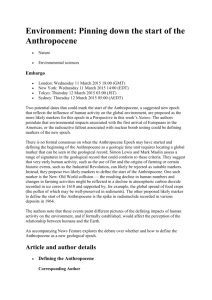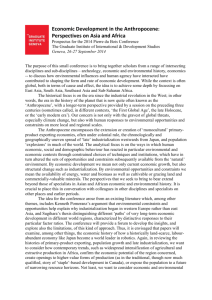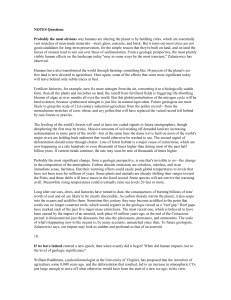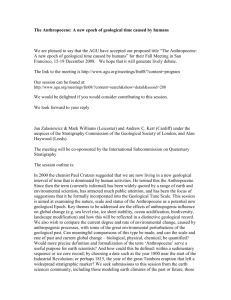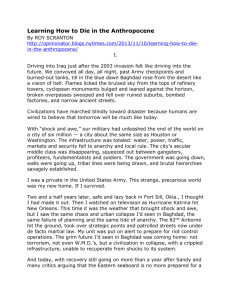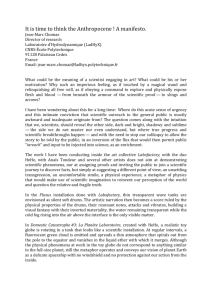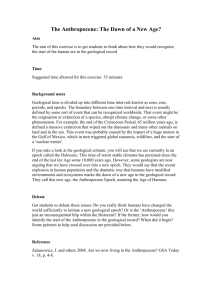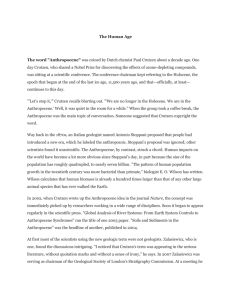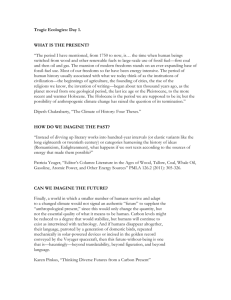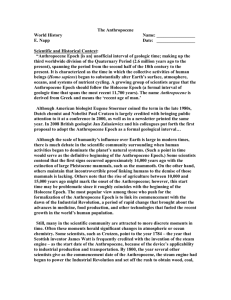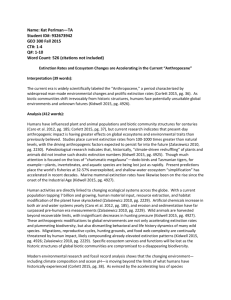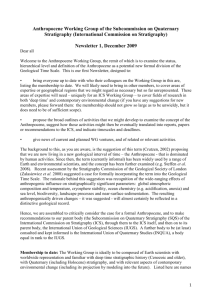Newsletter No.2 - Subcommission on Quaternary Stratigraphy
advertisement
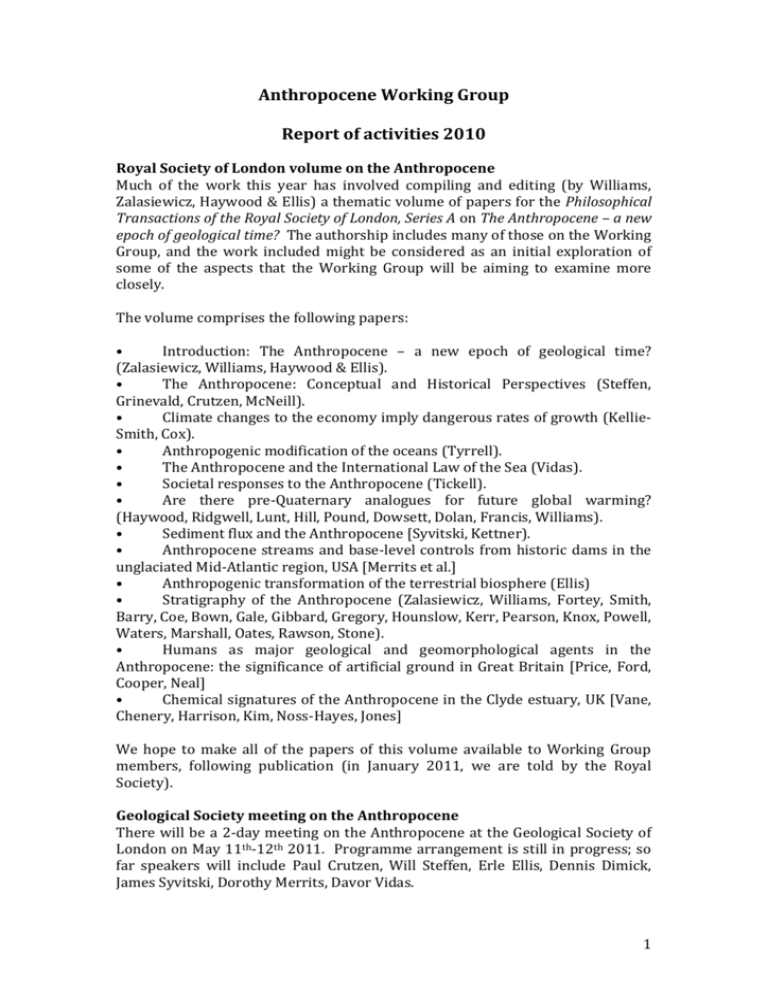
Anthropocene Working Group Report of activities 2010 Royal Society of London volume on the Anthropocene Much of the work this year has involved compiling and editing (by Williams, Zalasiewicz, Haywood & Ellis) a thematic volume of papers for the Philosophical Transactions of the Royal Society of London, Series A on The Anthropocene – a new epoch of geological time? The authorship includes many of those on the Working Group, and the work included might be considered as an initial exploration of some of the aspects that the Working Group will be aiming to examine more closely. The volume comprises the following papers: • Introduction: The Anthropocene – a new epoch of geological time? (Zalasiewicz, Williams, Haywood & Ellis). • The Anthropocene: Conceptual and Historical Perspectives (Steffen, Grinevald, Crutzen, McNeill). • Climate changes to the economy imply dangerous rates of growth (KellieSmith, Cox). • Anthropogenic modification of the oceans (Tyrrell). • The Anthropocene and the International Law of the Sea (Vidas). • Societal responses to the Anthropocene (Tickell). • Are there pre-Quaternary analogues for future global warming? (Haywood, Ridgwell, Lunt, Hill, Pound, Dowsett, Dolan, Francis, Williams). • Sediment flux and the Anthropocene [Syvitski, Kettner). • Anthropocene streams and base-level controls from historic dams in the unglaciated Mid-Atlantic region, USA [Merrits et al.] • Anthropogenic transformation of the terrestrial biosphere (Ellis) • Stratigraphy of the Anthropocene (Zalasiewicz, Williams, Fortey, Smith, Barry, Coe, Bown, Gale, Gibbard, Gregory, Hounslow, Kerr, Pearson, Knox, Powell, Waters, Marshall, Oates, Rawson, Stone). • Humans as major geological and geomorphological agents in the Anthropocene: the significance of artificial ground in Great Britain [Price, Ford, Cooper, Neal] • Chemical signatures of the Anthropocene in the Clyde estuary, UK [Vane, Chenery, Harrison, Kim, Noss-Hayes, Jones] We hope to make all of the papers of this volume available to Working Group members, following publication (in January 2011, we are told by the Royal Society). Geological Society meeting on the Anthropocene There will be a 2-day meeting on the Anthropocene at the Geological Society of London on May 11th-12th 2011. Programme arrangement is still in progress; so far speakers will include Paul Crutzen, Will Steffen, Erle Ellis, Dennis Dimick, James Syvitski, Dorothy Merrits, Davor Vidas. 1 Analysing anthropogenic change in the terrestrial biosphere Erle Ellis and colleagues this year published a key paper detailing how anthropogenic modification of the terrestrial biosphere developed through immediately pre-industrial times to the present: Ellis, E.C., Goldewijk, K.K., Siebert, S., Lightman, D. and Ramankutty, N. 2010. Anthropogenic transformation of the biomes, 1700 to 2000. Global Ecology and Biogeography. DOI: 10.1111/j.1466-8238.2010.00540.x. The Anthropocene and the Law of the Sea The concept of the Anthropocene has been quoted as a possible influence on the Law of the Sea in the newly published book Law, Technology and Science for Oceans in Globalisation, edited by Davor Vidas (Martinus Nijhoff Publishers: 2009), the opening section of three papers being entitled ‘The World Ocean in the Anthropocene Epoch’. The companion volume, to be published next year, will discuss these possible implications further. Book on the history of the Anthropocene concept The historian of science Jacques Grinevald (who has newly joined the Working Group) is in the process of completing a revised and updated version of his 2007 book La Biosphère de L’Anthropocène (Georg, Genève), which details, in chronological order, the history of the concepts (starting from Sadi Carnot, John Tyndall, George Perkins Marsh, Antonio Stoppani, Svante Arrhenius, Vladimir Vernadsky et alii) that have led to the modern (if still emerging) concept of the Anthropocene, following Paul Crutzen’s work. The new edition is due to be published in 2012, in French, and discussions are under way regarding a translation into English. Article in Enviromental Science and Technology This invited article, focussing in part on stratigraphic principles, is: Zalasiewicz, J., Williams, M., Steffen, W. & Crutzen, P. 2010. The new world of the Anthropocene. Environmental Science and Technology 44, 2228-2231. Membership to date Listed here are names of members to date and their contact details. Alejandro Cearreta Micropaleontología Facultad de Ciencia y Tecnología Universidad del País Vasco/EHU Apartado 644, 48080 Bilbao Spain e-mail: alejandro.cearreta@ehu.es Paul Crutzen 2 Max-Planck-Institute for Chemistry, Department of Atmospheric Chemistry, PO Box 3060, D-55020 Mainz, Germany . e-mail: paul.crutzen@mpic.de Erle Ellis Department of Geography & Environmental Systems, 211 Sondheim Hall, University of Maryland, Baltimore County, 1000 Hilltop Circle, Baltimore, MD 21250 USA e-mail: ece@umbc.edu Mike Ellis British Geological Survey, Keyworth, Nottingham NG12 5GG, UK e-mail: mich3@bgs.ac.uk Philip Gibbard (Chair SQS) Department of Geography, University of Cambridge,Downing Street, Cambridge CB2 3EN e-mail: plg1@cam.ac.uk Jacques Grinevald IHEID 20, rue Rothschild Case postale 136 1211 Genève 11 Switzerland jacques.grinevald@graduateinstitute.ch Alan Haywood School of Earth and Environment, University of Leeds, Leeds LS2 9JT, UK e-mail: A.M.Haywood@leeds.ac.uk Andrew Kerr School of Earth and Ocean Sciences, University of Cardiff, Wales, UK e-mail: kerra@cardiff.ac.uk Carlos Nobre Brazilian Institute for Space Research (INPE), Av dos Astronautas, 1.758 Jd. Granja - CEP: 12227-010 São José dos Campos – SP, Brazil e-mail: carlos.nobre@inpe.br Eric Odada Geology Department, University of Nairobi, Chiromo Campus, Riverside Drive P.O. Box 30197. Nairobi, Kenya e-mail: eodada@uonbi.ac.ke Simon Price British Geological Survey, Keyworth, Nottingham, NG12 5GG, UK e-mail: sprice@bgs.ac.uk 3 Andrew Revkin Dot Earth blogger, The New York Times http://www.nytimes.com/dotearth Senior Fellow, Pace Acad. for Applied Env. Studies revkin@gmail.com Mary Scholes School of Animal, Plant and Environmental Sciences, University of the Witwatersrand, Johannesburg, South Africa e-mail: mary.scholes@wits.ac.za Will Steffen The Australian National University, Canberra ACT 0200, Australia. e-mail: will.steffen@anu.edu.au Davor Vidas Director, Marine Affairs and Law of the Sea Programme Senior Research Fellow The Fridtjof Nansen Institute Norway Davor.Vidas@fni.no Mike Walker University of Wales, Lampeter, Wales, UK e-mail: walker@lamp.ac.uk Mark Williams (Secretary) Department of Geology, University of Leicester, University Road, Leicester LE1 7RH, UK e-mail: mri@le.ac.uk Jan Zalasiewicz (Chair) Department of Geology, University of Leicester, University Road, Leicester LE1 7RH, UK e-mail: jaz1@le.ac.uk An Zhisheng (Xi’an) The Institute of the Earth Environment, Chinese Academy of Sciences (CAS), 10 Fenghui South Road, Xi’an High-Tech Zone, Xi’an 710075, China e-mail: anzs@loess.llqg.ac.cn Anthropocene Working Group: suggested programme for 2011-12 Following these initial activities, that have assembled at least some of the relevant data, we propose collating data and discussion on key stratigraphic aspects of the Anthropocene. This would be by, in effect, considering evidence of contemporary global change of various types into their stratigraphic equivalents, as best as we can. Once this work is achieved (realistically, over the next few if 4 not several years), we may then be in a position to effectively consider the Anthropocene as a whole, and perhaps arrive at some agreement on its possible status, hierarchical level and extent. We can then forward the results, and whatever recommendations we arrive at, to our parent body, the Subcommission on Quaternary Stratigraphy, for them to consider and pass forward. Sub-groups, may examine each of the following aspects: 1) Lithostratigraphic signal Direct signal – of built, mined drilled and engineered structures, part of which might be termed the ‘urban stratum’. These features have specific structures and textures arising out of manufacture. They might be regarded in lithostratigraphic or biostratigraphic (‘trace fossils made by humans’) terms, but regardless of the precise means of classification they will form a distinctive facies: one that is arguably novel in the geological record. Aspects to be considered are the scale, extent, preserveability and variability of this facies. Indirect signal (physical) – of redirected/altered sedimentary regimes arising from the effects of land use change, the building of dams and coastal barriers, the effects of trawling on sea floor deposits, and so on. Indirect signal (chemical) – of changes in sedimentation rates/styles driven largely by chemical changes: notably in carbonate deposition in reef/pelagic limestone environments (pH mediated) and in mainly near-shore sedimentation (mediated by changes in oxygenation). 2) Biostratigraphic signal Species extinctions rates marine vs. non-marine comparison between and within different major groups, both plant and animal comparison at different trophic levels, and between rare and common taxa. comparison of hard-shelled and soft-bodied organisms i.e. analysis needs to focus on those organisms that may be commonly fossilized, to provide optimal comparison with fossil record. It would be good to establish links with the newly formed Intergovernmental science-policy Platform for Biodiversity and Ecosystem Services (IPBES), the body created to parallel the work of the IPCC for biodiversity. Changes in community structure direct and indirect effects of agriculture and human land use, including urbanization (biomes vs. anthromes etc). effects of climate change/warming (marine and non-marine) and pH changes (marine, lacustrine and terrestrial) extent, and direct and indirect effects of invasive species 5 3) Chemostratigraphy Changes to major element cycles of carbon, nitrogen, phosphorus, and direct resultant effects (including acidification). Changes to near-surface distribution of metals (lead, copper, cadmium etc) Changes to near-surface distribution of organic compounds, including polymers, aromatic and aliphatic compounds; contemporary effects and long-term preservation. Distribution of novel radionuclides. 4) Sea level (sequence) stratigraphy and related phenomena mass balance of ice masses global sea level trends (to date and forward-modelled) regional sea level variations changes in marine oxygenation levels from warming-related ocean stratification and anthropogenic ferilization (‘dead zones’). 5) Candidate boundaries and nature of definition, status, hierarchical level Comments welcome! – and volunteers/suggestions for memberships of these sub-groups. Jan Zalasiewicz (Chair) Mark Williams (Secretary) 1/12/2010 6
